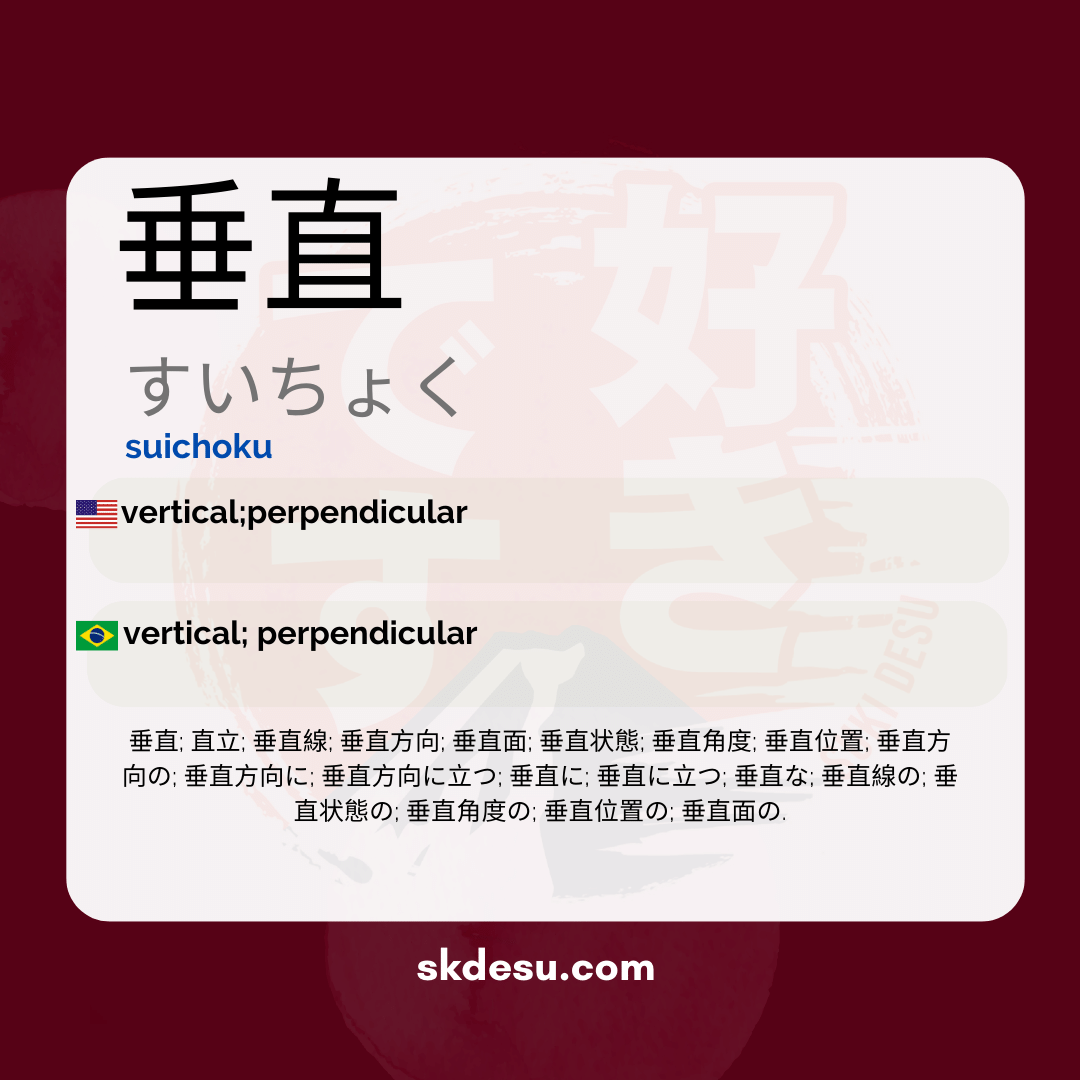Translation and Meaning of: 垂直 - suichoku
On this page, we will study the meaning of the Japanese word 垂直 (suichoku) and its translation into English. Let's see their different meanings, example phrases, explanations, etymology and the similar words.
Romaji: suichoku
Kana: すいちょく
Type: noun
L: jlpt-n2
Translation / Meaning: vertical; perpendicular
Meaning in English: vertical;perpendicular
Definition: Stand up and down on the floor or on the ground.
Sumário
- Etymology
- Vocabulary
- Writing
- Phrases
Explanation and Etymology - (垂直) suichoku
Etymology and Definition
The Japanese word 「垂直」 (suichoku) is composed of two kanji: 「垂」 (sui) and 「直」 (choku). 「垂」 means "to hang" or "to fall," while 「直」 means "straight" or "direct." Together, these characters convey the meaning of something in a state of "verticality," or "upright," perpendicular to the horizontal plane. The expression is used to describe the orientation of objects or structures that rise at a 90-degree angle to a flat surface, such as the ground.
Use and Applications
"垂直" is a word frequently used in architectural, mathematical, and even design contexts. In mathematics, "垂直" applies when discussing right angles, floor plans, and heights. In architecture and construction, it is vital to ensure that structures are "垂直" for the integrity of the building. Additionally, the term is relevant in descriptions of movements or orientations. For example, a rocket when launching ascends "垂直" to the ground.
Origin and History
Historically, the understanding and application of the concept of "垂直" have deep roots in ancient geometry and physics. Many engineers and architects from ancient civilizations, such as China and Greece, already used similar principles to guide their constructions and experiments. Japan, influenced by these civilizations, incorporated the use of "垂直" with the advancement of its own architecture and technology. This evolution enabled not only more stable buildings but also the understanding of natural phenomena and the development of navigation.
Forms and Variations
- 「垂」 (sui) - Used in contexts involving hanging or falling, it can be found in other descriptive words of that type.
- "直" (choku) - This kanji appears in words like "直線" (chokusen), meaning straight line, highlighting the aspect of rectilinearity.
The unique combination of these characters and their history reflect the importance of the concept of verticality in the various facets of human culture and learning. The understanding and use of 「垂直」 are not just technical but also an essential part of how Japan and the world perceive the space and structure around them.
Synonyms and similar words
- 垂直 (suichoku) - Vertical
- 直立 (chokuritsu) - Upright
- 垂直線 (suichokusen) - Vertical line
- 垂直方向 (suichokud方向) - Vertical direction
- 垂直面 (suichokumen) - Vertical plan
- 垂直状態 (suichokujotai) - Vertical state
- 垂直角度 (suichokukakudo) - Vertical angle
- 垂直位置 (suichokuichi) - Vertical position
- 垂直方向の (suichokud方向の) - Vertical (quality or characteristic)
- 垂直に立つ (suichoku ni tatsu) - Stand upright
- 垂直に (suichoku ni) - Vertically
- 垂直な (suichoku na) - What is vertical
- 垂直線の (suichokusen no) - Vertical line (quality or characteristic)
- 垂直状態の (suichokujotai no) - From the vertical state (quality or characteristic)
- 垂直角度の (suichokukakudo no) - Of vertical angle (quality or characteristic)
- 垂直位置の (suichokui no) - From the vertical position (quality or characteristic)
- 垂直面の (suichokumen no) - From the vertical plan (quality or characteristic)
Words with the same pronunciation: すいちょく suichoku
How to Write in Japanese - (垂直) suichoku
See below a step-by-step guide on how to write the word by hand in Japanese (垂直) suichoku:
Example Sentences - (垂直) suichoku
Below are some example sentences:
Chūjiku ni tatte kudasai
Please stand upright.
Remain vertically.
- 垂直 (suichoku) - vertical
- に (ni) - particle indicating direction or location
- 立って (tatte) - stand
- ください (kudasai) - por favor
Other words of the same type: noun
See other words from our dictionary that are also: noun

